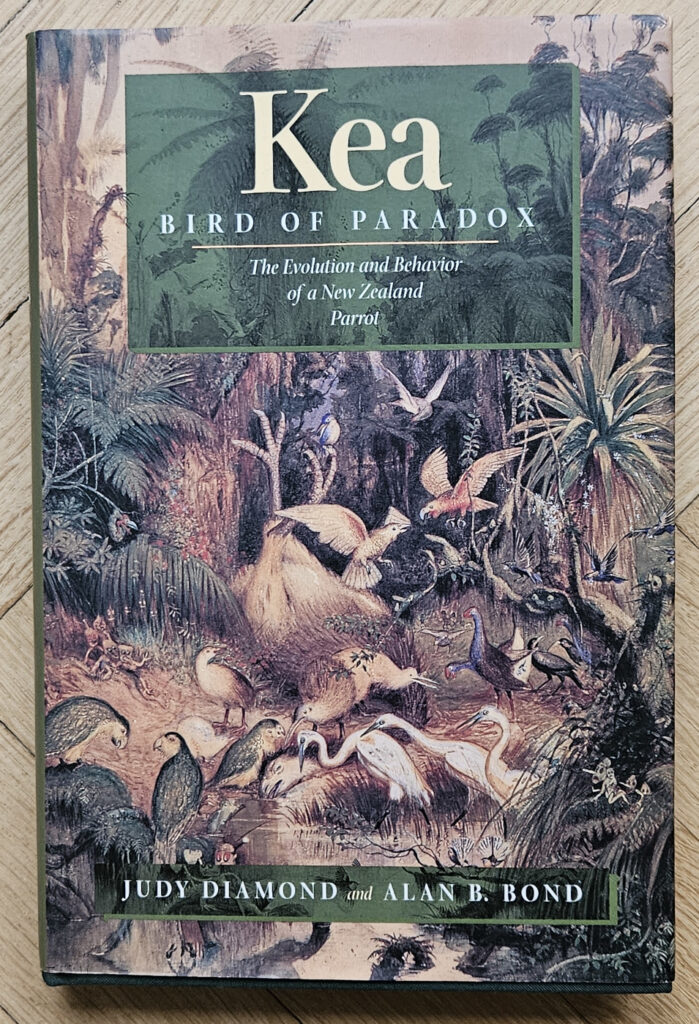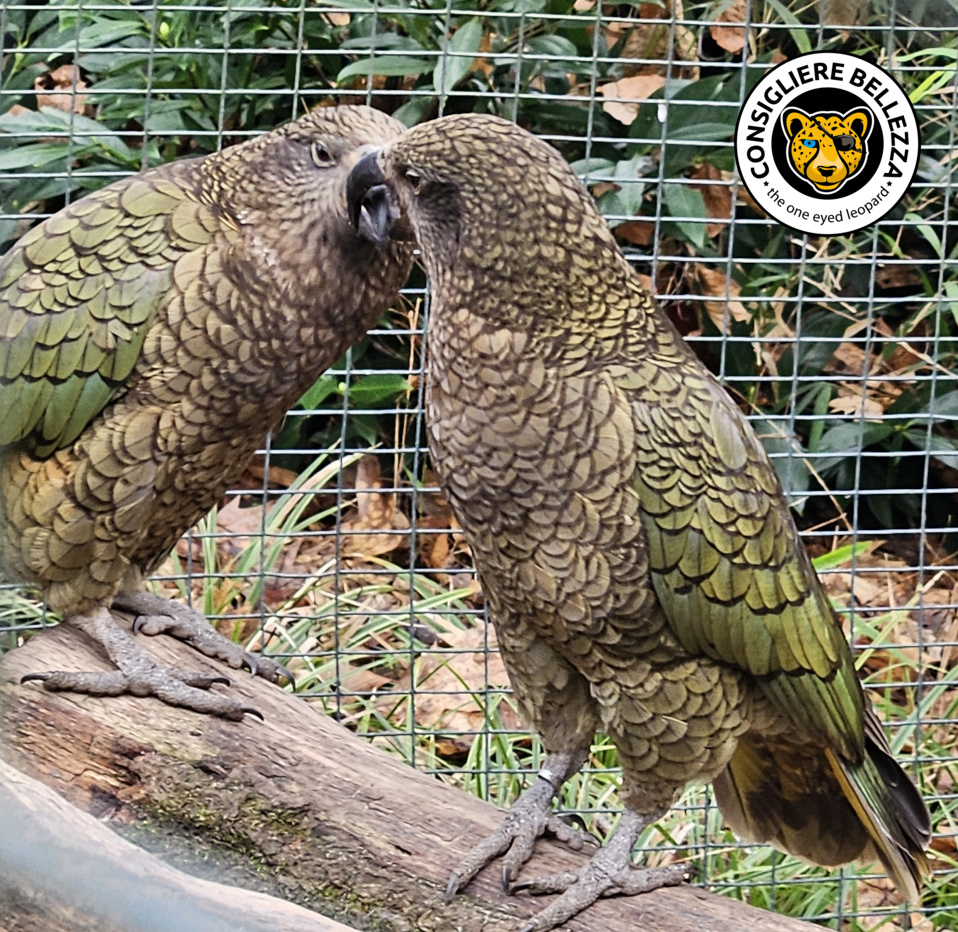There are not many books about Kea parrots. Anybody who saw one of the documentaries in TV about the parrots dismantling tourist’s cars in New Zealand and playing passionately with each other wonders why there are not more books or more information in general about those birds. There is no doubt that Keas are extremely intelligent. Their playfulness is legendary. According to common knowledge, they are even smarter than ravens, who head the list of bird intelligence.
Youtube is full of videos of Keas cheekily playing with whatever humans bring to their area and diminishing it to shreds, not in an aggressive way, but clearly in the pursuit of fun. Tourists who go to their region know what they get into, and they do it with curious anticipation.
The most comprehensive study on Keas is professor Judy Diamond and professor Alan Bond’s book “Kea – Bird of Paradox” from 1999. I draw largely from that book and a bit from two new books from 2024. They were published by Dr. Morris Hart and Dr. Mick Walsh. Both deal with keeping Kea parrots as pets and are very similar in cover and content. Keas, being so intelligent and playful have special needs, like highly talented children often do not well in a normal school. Letting them fly free in your house or flat is probably the worst idea you can have if you like your house as it was – if you do have a lot of space and can give them aviaries with earth on the floor and plants all around, toys, your time and you have more than one Kea, then it might work. They are certainly happy for any attention they can get.

Keas have beautiful green feathers, only under their wings the plumage is flaming red. Their beak is an exceptional tool, thin and pointed like a needle thin hook. They do not have a lot of force in their beak, like other parrots, but the damage to soft things can be impressive.
Keas live in the Southern part of New Zealand, in alpine regions. Thus, Nestor Notabilis, as their species is named, is the only alpine parrot in the world. The area is naturally very scarce and their living not earned easily. One of the first questions that arises is why they do not move to other quarters, where food is plentiful and their survival easier. Generations earlier Keas lived in wider parts of New Zealand, but it seems never for long. Keas lived in the country before humans and the predators they brought with them (cats, rats etc). Judy Diamond and Aland Bond explain that the Kea population was subject to fluctuation even in years without human interaction, and it is not explainable why.
Humans became a mortal danger for Keas only when the parrots were categorized as sheep killers. To sustain their meager diet, Keas started to feed from sheep carcass, but not only that. They tried to draw fat from sheep and sucking this fat with their sharp beaks naturally injured sheep. Sheep got infections and died – so the legend of the sheep killing parrot was born. They were hunted almost to extinction afterwards by European settlers. All this happened only 150 years ago.
Another problematic treat is the Kea habit to breed on the ground. Their nests are easily plundered by rats and opossums, which only lately led to the observation of individual Keas building nests in trees. Hopefully this will become a new way forward for the Kea population. Other parrots in New Zealand do this since a long time, e.g. the wood parrot Kaka, the closest relative to the Kea. The Kaka does live in a better environment, more food available, less scarce conditions, but the Kaka is also less intelligent. One wonders if that is curse or blessing.
The one big weakness of Keas as a species seems their attachment to their natural alpine habitat. Today, as a protected species, they could venture to other regions without much danger. As they are smart, they should have realized their revised status by now. But the Keas stay stubbornly in the scare regions they always lived in. Judy Diamond and Alan Bond draw a similarity to us humans there. Through their flexibility and intelligence, they can adapt to a lot of changes in their surroundings, but they seem bound to the one world they live in, for good or bad.
Indeed, Keas are like us humans as a species in many character traits.
Keas learn and are willing to learn their whole life.
Keas are attached to their home area deep from within.
Keas honour their females and the groups are led by female parrots – here the Keas are a bit ahead of us…
Keas are seen as being able to deal with everything that comes towards them, due to their flexibility. But that is not true. Often their adversaries win, because they are stronger or come in groups.
But still – Keas show an eagerness to play and have fun, just for the fun itself. This is wonderful and a behaviour we humans should copy, the sooner the better. For our own sake.
All rights to the books belong to:
Diamond, Judy / Bond, Alan B.: Kea – Bird of Paradox, The Evolution and Behaviour of a New Zealand Parrot, 1999, published by University of California Press, Ltd, London, England, printed in the United States of America, ISBN: 0-520-21339-4
Hart, Morris, Dr.: How to Care for a Kea: A Complete Guide to Having a Kea as a Pet, Pet Owners Manual, 2024, Independently published, ISBN: 979-8324371739
Walsh, Mick, Dr.: Caring for Kea: A Complete Guide to their Habitat, Diet, and Having a Kea as a Pet, 2024, Independently published, ISBN: 979-8324840396
The latter two books are new, but there is no information available about the authors. Their cover and content are very similar. I thought that strange, but did not want to exclude the books. The content seems ok, although a bit superficial.

